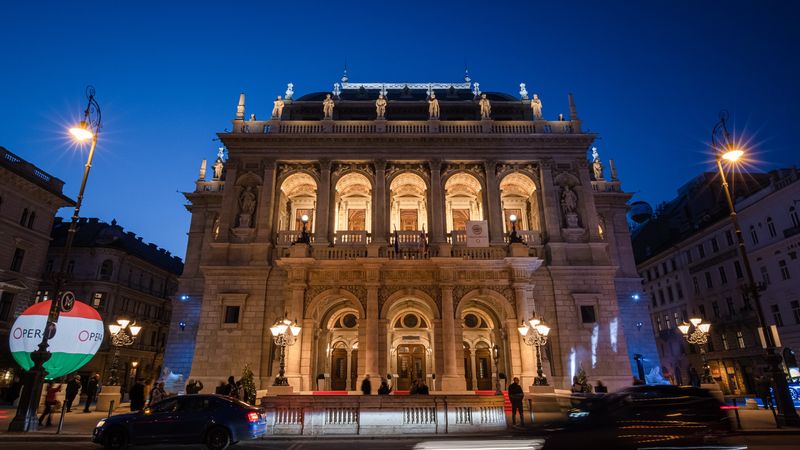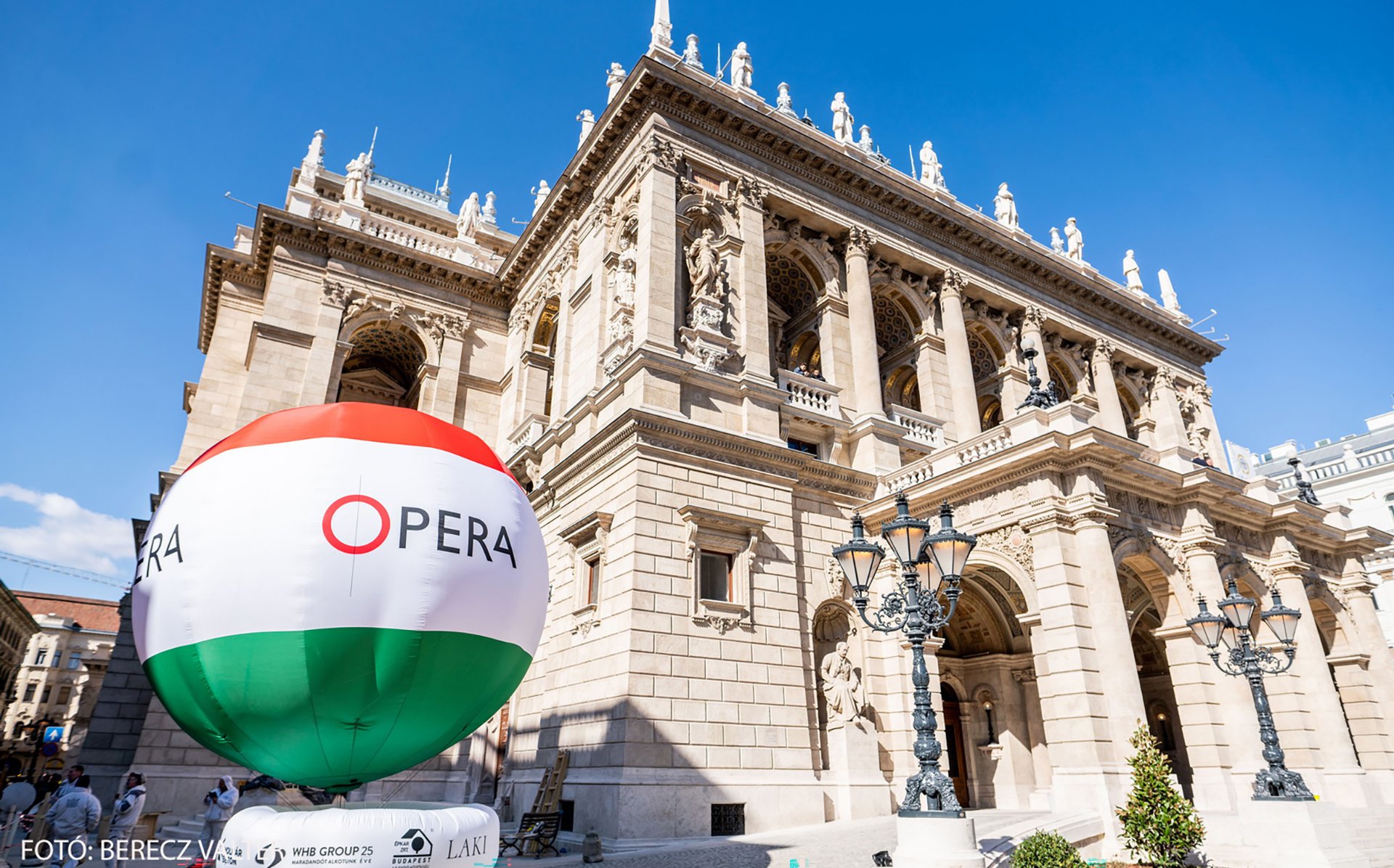
Following an extensive refurbishment and modernisation that lasted for nearly five years, the historic Opera House was reopened with a spectacular gala on 12 March 2022.
About the reconstruction of the Opera House
The Hungarian State Opera opened in 1884, and in the 138 years since, there have been two major reconstruction projects. During the first one, led by István Medgyaszay in 1912, the key change, one that had been visible until recently, was that two rows of seats were added to the ground floor of the auditorium, where the wooden substructure was replaced with an iron structure. At the same time the orchestra pit was deepened and extended towards the stage—as a result some orchestra members sat under the stage. It was also at that time that the ground floor cloakroom was created.
Between 1980 and 1984, the Opera House underwent a comprehensive renovation according to plans by Mária Siklósi, and the Administrative Building in Hajós Street was built. The Asphaleia upper and lower stage engineering system, almost 100 years old at the time, was replaced to what was available, namely some 20-year-old technology from East Germany, and the parapet of the orchestra pit was made of reinforced concrete. Functional areas and areas used by the audience were modernised and renovated along with the facade, and the 10-storey Administrative Building was constructed at 11 Hajós Street, with an underground tunnel leading from the building to the Opera House. As the Erkel Theatre’s infrastructure was insufficient, additional rehearsal rooms were created in the new building, tailor and dressmaker workshops moved here with most of the administrative offices, and the boiler room of the Opera House was installed on the top floor.
There have been several additional, smaller reconstruction projects at the Opera House that were not always precisely documented or archived. Originally using gas lighting, the building was connected to the electric grid at the turn of the 19th and 20th centuries in 3 stages, and at the end of the 19th century, 5 of the 9 murals by Árpád Feszty were replaced with paintings by Ignác Újváry after a leakage in the first floor lounge (the Feszty bar). The building suffered relatively minor damage during World War 2 and was repaired after 1945, and the areas used by the audience were gradually renovated in the 1950s and 1970s, using the simpler colours and materials available at the time. Originally, there were 16 limestone statues of composers on the facade of the Opera House along the cornice, but by the 1930s they were in such a terrible condition that they needed to be removed. In 1965 they were replaced with statues in a different style and of different composers, including some whose works were not part of the repertoire of the Opera.
When he was appointed government commissioner in 2011, General Director Szilveszter Ókovács declared that the replacement of the stage engineering system was among his medium term plans—it was noisy and obsolete and its maintenance and operation had regularly caused difficulties for the Opera since the 1990s. While the restorers of the institute maintained the areas used by the audience, there had been no comprehensive renovation of the functional areas since 1984. This meant that there were no proper dressing rooms for the orchestra and there was no fire alarm system; the electric network did not meet the requirements of the time, the mechanical systems were obsolete, the was no climate control and there were leaks in the basement.
The idea was to move the costume and scenic workshops—located in the Opera House, the Administrative Building and in nearby streets, in dire need of space and struggling with logistics issues—, most of the costume storage and the stage sets and scenery—stored in a dozen different locations in the city—to a single base to lighten the load of the Ybl Palace. This base, which also has rehearsal rooms and a stage, is the Eiffel Art Studios. Built on the premises of the former Northern Railway Maintenance and Engineering Works, it was completed in 2020, and together with the Erkel Theatre, which reopened in 2013, it was instrumental in maintaining the operation of the institution during the lengthy renovation project.
The Government of Hungary made a decision to modernise the Opera House in 2016, and the project was to include the renovation of the facade, the modernisation of the stage engineering system and acoustics, the improvement of the comfort of the auditorium, the reconstruction of the orchestra pit, the restoration of historic spaces, the replacement of the public utility network, electric and mechanical systems, and the renovation of the Administrative Building and smaller nearby properties.
The general contractor was the consortium of West Hungária Bau Kft. (WHB), Épkar Zrt. and Laki Zrt., the only tenderer at the public procurement, with an architectural and engineering programme developed by the ZDA – Zoboki Design and Architecture firm. Bosch Rexroth Kft. won the tender for the stage engineering system against fierce competition.
The company of the Opera said goodbye to the building at the end of the 2016/17 season, and the construction started in a design & build system, where design and construction processes, while built on each other, are scheduled parallelly. Based on the exploratory work before and after the building was closed and on research done by the architect firm and the restorers, in late 2018 the government amended its decision and agreed to the comprehensive, historically accurate reconstruction of the Opera House, and from 2019, Opera Vagyonkezelő Kft., a company under Városliget Zrt., took over the increased volume of tasks associated with the reconstruction.
Modernisation of audience spaces
The project, which also involved the renovation and decoration of the whole facade, the decorative lighting of the main front and the roof, and the covering of the roof, was completed on 10 March 2022. In the restoration of the historic parts of the building used by the audience, the designs were based on the explorations of the restorers, archive documents and original ideas, and the aim was to bring back the original colours and materials of the facade and the interior spaces. The lighting of the interior was also renovated, luminaries similar to the originals were installed in the sconces and the grand chandelier in the auditorium. New, two-tiered chandeliers were installed in the main stairway to provide better lighting to the ground floor area. The original colour of the peroxided oak paneling in the Red Salon was also restored. The arrangement of the first floor buffet, the Feszty Bar, was also changed, now the counters, which evoke the original furnishing, are on the side of the room facing Andrássy Street. Zsiday Group stays on as the culinary partner of the Opera House, operating the buffet in the auditorium and the Opera Café on the ground floor.
A new, ornate curtain was installed in the extended stacking space, and an imitation bronze cover was created for the iron curtain in the scenic workshop, based on a sketch from the time of the opening that had not been realised. The so-called tin curtain was also created in the scenic workshop—this, in fact, is a laminated board and, as opposed to the previous velvet house curtain, it does not absorb sound. The original size of the stalls, which had been extended earlier, was restored except for the 2 rows added in 1912, which means the angle of the stalls is now similar to the original. The substructure of the stalls now has a wooden frame, and between a chamber here that is used for distributing air for heating and ventilation and the orchestra pit there is a passage for sound that is intended to improve the acoustics of the auditorium. For the same reason, the rows on the ground floor are now arranged in one block, in a horseshoe shape, as it was first designed by Ybl (it was constructed differently then), this way the covering of the side walls of the boxes will reflect the sound waves better, helping them die away. The wooden boards separating the ground floor boxes were replaced with wickerwork, again, to improve the acoustics.
In the now smaller auditorium, the rows are further apart and the seats are larger and more comfortable, improving the experience of the audience members. In the boxes there are now only 4 seats instead of 6, and tickets can be bought per box. As a result, the capacity of the auditorium decreased from 1200 to 1000. On the gallery there is standing room students, and in some places with restricted visibility you can read the score. The visually impaired are provided audio narration and the hard of hearing have access to an audio induction loop in one row in the stalls. To further improve accessibility, lifts were installed for the audience by the stairs to the galleries on the Dalszínház Street and Hajós Street sides, and the levels of the staircase to the gallery were aligned with and opened to the stalls and the upper level boxes.
Modernisation of functional areas
The central element of the renovation is the computerised upper and lower stage engineering system: it will be absolutely silent and, like before, it has 6 bridges and 10 side podia; the height and also the speed of the lifts can be controlled. Similarly, the level of the three-part orchestra pit is also adjustable with lifts, and there are built-in tuners in the inner wall.
Now that the carpentry workshop has moved from the basement, there is a modern dressing room for the orchestra, and there are also 6 new rehearsal rooms for the musicians and an instrument storage. The dressing rooms of the solo singers now have a shower and a basin, and the ballet ensemble has access to a sauna for recreation.
On floors 4 and 5, where the painting rooms used to be, new rehearsal rooms were created for the ballet ensemble and the artists of the Opera House where they can prepare for the performances in a setting similar in size to the stage. The secretariat of the deputy director, the directors and the artistic directorate have large, modern, open plan offices separated with glass walls on floors 1, 2 and 3. In addition to the above, the basement and the rain drainage tunnels were waterproofed and heat insulation was installed on the windows, the public utility network was modernised and an electronic system now covers the whole area of the building (stage manager intercom system, audience information system, IT network, mobile phone signal booster, Wi-Fi network, security and access systems). The Opera has also had the stage lighting and audio equipment renewed, its valuable historic pieces of furniture and artwork restored and purchased office furniture and equipment, pianos and other musical instruments, and kitchen technology for the buffets.
The construction work of the Administrative Building is scheduled to be completed this year, and also the work on the former costume storage on floor 5, which will be converted to a chamber theatre and an event venue under the name Medgyaszay Room. The reconstruction of the royal stairs and the Bertalan Székely Room and the restoration and replacement of the statues on the facade along the cornice are scheduled for later.
The refurbished Budapest Opera House
